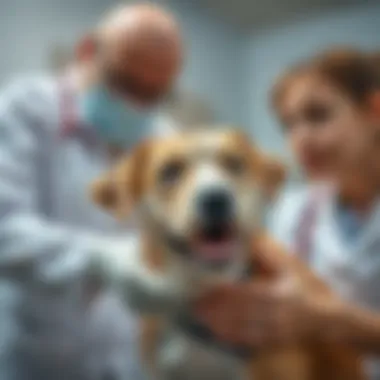Exploring State Farm's Pet Insurance Options


Intro
When we think of keeping our furry companions happy and healthy, one can't help but bump into the subject of insurance. It begs the question: does State Farm actually dip its toes in the waters of pet insurance?
Pet insurance isn't just about keeping up with the Joneses; it's more like a lifeline when the unexpected comes knocking. Whether it’s a sudden illness or an unfortunate accident, one trip to the vet can sometimes cost an arm and a leg. That’s where insurance shines. State Farm has made a name for itself in various insurance sectors, and exploring their offerings for pet insurance can surely pique curiosity.
In this article, we'll get into the nuts and bolts of what State Farm has to offer regarding pet insurance. We'll unpack the coverage details, chew through various policy features, and serve up insights on pricing. Furthermore, consumer feedback and experiences will help color our understanding of the actual benefits.
Stay tuned as we also glance at how State Farm stacks up against the competition in the pet insurance arena. This isn't just about pet insurance options; it’s about safeguarding the health of your beloved animals and making informed choices that will ultimately lead to peace of mind.
Understanding Pet Insurance
Understanding pet insurance is not just a trendy topic among pet owners; it holds considerable weight in the world of responsible pet ownership. With escalating veterinary costs, pet insurance has emerged as a crucial financial tool for many households. Knowing the ins and outs of pet insurance is essential for making informed decisions about healthcare for furry companions.
Definition and Purpose
Pet insurance essentially provides coverage for veterinary expenses that stem from accidents or illnesses that affect your pet. Its purpose is clear: to alleviate the financial burden of unexpected vet bills. When pet owners choose to invest in this type of insurance, they can ensure that their pets receive timely medical attention without the constant worry of how to afford treatments. Think of pet insurance as a safety net, designed specifically for your cherished animal.
Common Types of Coverage
When diving into pet insurance, it's crucial to recognize the diverse types of coverage available. Different plans cater to various needs and financial situations, making it imperative for pet owners to assess their specific requirements. Here’s a closer look at some common options:
Accident-only Plans
Accident-only plans focus solely on incidents that occur unexpectedly, such as injuries from accidents. This specific aspect appeals to pet owners who may not want the full-spectrum coverage or perhaps are looking to save a few bucks on premiums. A key characteristic of accident-only plans is their affordability compared to more extensive options. These plans might not cover illnesses, but they ensure you’re covered if, for example, your beloved cat decides to leap off a kitchen counter and lands awkwardly.
The unique feature here is the straightforward nature of these plans. Pet owners appreciate knowing that in case of an accident, they won’t face crippling vet bills, which can be a relief when emotions run high.
Comprehensive Plans
In contrast to accident-only plans, comprehensive plans cover a wider array of incidents, including both accidents and illnesses. This broad spectrum of coverage makes comprehensive plans a favored choice among those who want to ensure holistic health for their pets. A prominent feature is the ability to manage both unexpected injuries and chronic conditions, ultimately contributing to long-term financial stability in pet healthcare.
However, it’s worth noting that while these plans offer extensive coverage, they can come with higher premiums, which might be a limiting factor for some pet owners. Nevertheless, investing in a comprehensive plan often pays off in cases where substantial medical intervention is needed.
Wellness Plans
Wellness plans take a different route by focusing on preventive care. They often include routine check-ups, vaccinations, and preventive tests that can keep your pet healthy in the long run. The key characteristic here is their emphasis on preventative health measures rather than just reactive care.
This approach can help pet owners plan financially for routine vet visits, encouraging regular checkups rather than waiting until a serious issue arises. However, wellness plans typically do not cover emergencies or significant health issues, making it vital for pet owners to evaluate their needs carefully. The unique aspect of wellness plans positions them as an intriguing choice for those seeking a proactive strategy to pet healthcare.
Benefits of Pet Insurance
Ultimately, pet insurance offers several benefits that extend beyond mere financial support. It enables pet owners to have peace of mind, reassuring them that when it comes to their pets' health, they are not alone in the financial aspect. Some other notable advantages include:
- Access to a broader range of veterinary services: With insurance, pet owners can afford treatments that they might opt out of without coverage, expanding on the well-being of their pets.
- Encouragement for preventative care: Knowing that you have coverage often motivates pet owners to take their pets for routine checkups, which helps catch health issues early.
- Less stress during emergencies: With the cost of veterinary care covered to some extent, you can focus more on helping your pet rather than fretting over expenses.
In summary, understanding pet insurance is not just about knowing what policies are available; it's about grasping how these policies play a vital role in ensuring the well-being of pets and peace of mind for their owners. The nuances of coverage types, from accident-only to comprehensive plans, enrich the landscape of pet ownership, making it alternatively secure and unpredictable.
State Farm Overview
Understanding the landscape of insurance is crucial, especially when navigating options for pet protection. State Farm stands as one of the biggest names in the insurance industry, renowned for its extensive portfolio. This section elaborates on State Farm's background and the variety of insurance products it has to offer, shedding light on how these factors interlock to create its comprehensive service repertoire.
Company History
State Farm was founded in 1922 by George J. Mecherle, originally aimed at providing automobile insurance to farmers. Over the decades, the company expanded its services drastically. Today, it boasts being one of the largest property and casualty insurance providers in the United States. It stands out not just because of its size, but also due to its customer-driven philosophy. From humble beginnings, State Farm grew into a household name known for its distinctive marketing strategy and its iconic slogan, "Like a good neighbor, State Farm is there."
This long-standing history allows customers to feel a sense of trust and reliability when engaging with State Farm. Its track record reinforces the importance of understanding who you’re potentially entrusting with your finances and well-being.


Insurance Products Offered
State Farm offers a wide array of insurance products. Each of them provides tailored options to meet the diverse needs of individuals.
Auto Insurance
State Farm's auto insurance is perhaps one of its flagship offerings. It's designed to meet various requirements, whether you're looking to cover your vehicle against collisions or liability claims. A key characteristic of their auto insurance is the customizable coverage options that allow policyholders to adjust their plans according to their driving habits and needs. This flexibility is a boon for drivers who want to avoid paying for coverage that might not align with their specific situation.
One unique feature is the Drive Safe & Save program, which rewards safe driving habits with discounts. However, some individuals may find the system of monitoring driving behaviors intrusively structured, which could be viewed as a disadvantage.
Homeowners Insurance
When it comes to homeowners insurance, State Farm does not skimp on options. The policies generally provide fundamental coverage for damage to your home and personal property. A significant feature is their Personal Property Coverage, which ensures that one’s belongings are protected against various risks. This is especially important for homeowners who want peace of mind regarding their investments.
While many find State Farm's homeowners insurance beneficial due to its extensive coverage options, there can be some critique regarding the higher premiums compared to smaller insurers. Nevertheless, the depth of service offered by State Farm continues to be a strong selling point.
Life Insurance
Life insurance is essential for many families, and State Farm offers a variety of options geared toward different needs. They provide term and permanent life insurance, ensuring that policyholders can find what fits best for their financial and personal situations. A key characteristic of their life insurance offerings is the convertibility option, which allows term policies to be switched to a permanent policy without a medical exam. This flexibility is appealing for those who might experience life changes in the future.
However, the complexity of choices can sometimes lead to confusion, especially for first-time buyers.
Pet Insurance
Delving into pet insurance, State Farm offers plans that protect pet owners against unexpected veterinary bills. The customizable coverage allows for adjustments based on the specific needs of the pet, whether it’s for accidents, illnesses, or even routine care. This offering is deeply appreciated, given that veterinary costs are spiraling in many areas.
Still, some policyholders might find the exclusions on pre-existing conditions a point of contention, as it could limit the benefits available for older pets or those with past medical issues. Despite this, State Farm’s reputation and scale lend a reassuring layer of credibility for potential buyers in this area.
In summary, State Farm's extensive history and array of insurance products establish it as a formidable player in the market. Understanding these elements is vital, especially for consumers aiming to protect their assets and well-being comprehensively.
State Farm's Pet Insurance Offerings
With the rising costs of veterinary care, exploring various options for pet insurance has become a crucial task for many pet owners. State Farm’s pet insurance offerings come into play as a viable solution for pet parents wanting to safeguard their furry companions’ health. In this section, we take a closer look at the specific elements of State Farm’s pet insurance: policy features, customization options, and potential exclusions.
Policy Features
State Farm understands that having a pet is akin to welcoming a new family member. Therefore, their policy features are designed to provide comprehensive support during both expected and unexpected health challenges.
Coverage for Injuries
Coverage for injuries is one of the top draws of State Farm's pet insurance. This type of coverage ensures that if your pet gets injured—say, they dart across the street chasing a squirrel—you're not left scrambling to cover vet bills that could soar into the thousands. The key characteristic of coverage for injuries is its straightforward approach: if your pet needs emergency treatment after an accident, you’re covered.
Many pet owners find this particularly beneficial because injuries can happen out of the blue and represent an immediate financial burden. Importantly, this coverage often includes promotions for accidents, meaning you don’t have to dig through fine print to know what’s protected. It provides peace of mind, knowing you have support during crises, which is critical for all pet owners. However, a potential drawback is that some exclusions might apply depending on the type or extent of treatment needed after the injury.
Chronic Conditions
Chronic conditions can weigh heavily on any pet owner’s wallet. State Farm recognizes this concern and includes coverage for chronic conditions in its offerings. Whether your dog has diabetes or your cat requires ongoing treatment for allergies, this feature is a big help. The key characteristic here is that it allows for consistency in treatment, helping ensure that pets continue to receive the care they need without the burden of escalating veterinary costs that can often accompany chronic illnesses.
This coverage is especially advantageous, as it prevents sudden, overwhelming financial pressure due to multiple treatments over time. However, it's essential to be aware of any pre-existing condition clauses that may limit coverage options when first signing up.
Preventive Care
Preventive care is another significant aspect of State Farm's pet insurance, catering to those who believe that an ounce of prevention is worth a pound of cure. This feature covers a range of services, from routine check-ups to vaccinations, ensuring your pet gets the preventive measures they need to stay healthy.
The key characteristic of preventive care is its proactive approach; it emphasizes maintaining your pet's health rather than just reacting to ailments. Numerous studies suggest that regular check-ups can prevent substantial health issues down the line, making this coverage a popular choice among proactive pet owners.
While the benefits are clear, one must consider that preventive care may come with an additional cost in premiums. Balancing the investment against potential veterinary savings depends on individual circumstances and preferences.
Customization Options


A noteworthy point about State Farm's pet insurance offerings is their ability to cater to individual needs. Pet owners can customize their policies based on specific requirements. For example, policyholders can choose different levels of deductibles, annual limits, and even varying coverage percentages. This allows you to tailor coverage to fit your pet’s unique health situation and your financial comfort level.
Exclusions to Consider
Like any insurance product, there are exclusions worth noting. State Farm's pet insurance is no different. Some common exclusions may include pre-existing conditions, cosmetic procedures, or certain behavioral therapies. Being aware of these exclusions beforehand is vital so that you enter into a policy fully informed about what's covered and what's not. Knowing these details will help you navigate potential pitfalls and establish realistic expectations regarding your pet's care.
Cost Analysis of State Farm Pet Insurance
When it comes to pet insurance, costs can create a significant impact on a pet owner’s wallet. Understanding the cost analysis of State Farm's pet insurance is essential for making a smart financial decision. Insurance isn't just about having a policy; it's about knowing how to match it with your budget and your furry friend's needs. Therefore, a detailed breakdown of factors influencing premiums and comparing State Farm’s offerings to those of other providers is crucial.
Factors Influencing Premiums
Several elements dictate what you will pay for State Farm's pet insurance. Here’s a breakdown:
Pet Breed
One major aspect is the pet breed. Different breeds can have varying health predispositions that influence insurance rates. For example, larger dog breeds like Great Danes often suffer from specific health issues, leading to higher premiums on policies. On the flip side, smaller or less predisposed breeds might enjoy lower costs.
- Key characteristic: Some breeds come with a genetic makeup that can affect their longevity and health.
- Unique feature: Larger breeds might need more frequent care, resulting in potentially higher veterinary costs.
- Impact on costs: While adopting a certain breed might fulfill your preference, it’s wise to consider the long-term financial implications related to pet insurance premiums.
Age of the Pet
The age of the pet is significantly intertwined with insurance costs. Generally, younger pets are less likely to have pre-existing conditions that lead to higher claims. In contrast, as pets age, they tend to develop various health problems, and thus, premiums can climb.
- Key characteristic: Puppies and kittens often incur lower premiums compared to older pets.
- Unique feature: This reflects the potential for more significant health risks as pets grow.
- Impact on costs: If you’re adopting a senior pet, it’s important to review the overall cost of insurance, as it could be a hefty investment over time.
Location
Your location plays a pivotal role as well. Insurance costs can vary widely based on where you live; metropolitan areas often have higher veterinary costs compared to rural regions.
- Key characteristic: Urban settings might have higher costs for services and treatments, ultimately affecting insurance prices.
- Unique feature: Regional veterinary care norms can influence the pricing structure of policies.
- Impact on costs: Living in a city may mean your premiums are higher due to increased competition among veterinarians or established treatment pricing.
Comparison with Other Providers
When considering State Farm’s pet insurance, it’s beneficial to compare it with other providers. Each insurer has its own policy structure, premiums, and benefits.
- Some may offer more extensive coverage but at a premium price, while others might provide basic coverage with a lower monthly cost.
- Look for customer reviews and experience with claims. Easy claims processing, good customer service, and protection against breed-related conditions can be significant distinguishing factors.
As a pet owner, this analysis empowers you to navigate the often-complex world of pet insurance with clarity. Remember, when evaluating costs, think of it not just as an expense, but as an investment in your pet’s future health and well-being. You can find more information on insurance options at State Farm or explore discussions on Reddit about experiences with pet insurers.
"A penny saved is a penny earned," but when it comes to your pet’s health, spending wisely can actually lead you to greater peace of mind.
Customer Experiences with State Farm Pet Insurance
Understanding how customers feel about their experiences with State Farm's pet insurance can give potential buyers valuable insights. Customer experiences can reveal much about the overall service, the responsiveness of the claim process, and how well the insurance plans meet the needs of pet owners. Testimonials and reviews can highlight positive aspects, but they can also point out drawbacks that may not be obvious at first glance. In the world of insurance, the consumer's perspective can act as a beacon, guiding individuals when choosing the right plan.
Review Analysis
When diving into customer reviews, it’s crucial to look beyond mere star ratings. Reviews often detail specific instances, allowing prospective customers to gauge how State Farm handles its pet insurance. Many users commend the range of coverage that State Farm offers as well as the clarity of the policy terms. A few common themes emerge from customer feedback:
- Clarity of Coverage: Customers often express appreciation for clear explanations of policy coverage, which helps avoid confusion. Knowing what's included—and what's not—before filing a claim helps pet owners feel secure in their choices.
- Customer Service: Reports suggest State Farm agents exhibit professionalism and promptness in responding to inquiries. Many patrons note their satisfaction with the ease of communication, whether by phone or through online platforms.
- Payout Timeliness: Timeliness in claims processing appears to be a critical factor for many pet owners. Most customers seem pleased with the speed at which their claims are settled, which speaks to State Farm's efficiency.
However, not all reviews are glowing. Some policyholders find the premiums on the higher side compared to competitors. Additionally, a few customers lamented that certain treatments or conditions weren't covered as they'd expected. This duality of experiences underscores the importance of reading the fine print and understanding the limitations of any plan fully.
Claim Process Insights
The claims process is often the litmus test for any insurance provider. A simple, user-friendly system can arguably enhance customer satisfaction significantly. Here’s an overview of what potential State Farm policyholders might expect when filing a claim for their pet:


- Filing a Claim: According to various user experiences, submitting a claim can be done conveniently through the State Farm website or mobile app. Customers generally find the online forms straightforward, with a logical flow that doesn’t require a degree from a top-tier university.
- Supporting Documentation: For many, the requirement for detailed documentation can feel laborious. Owners are often asked to provide invoices, medical records, and treatment notes. While this may seem like a nuisance, it’s crucial for a thorough assessment of the claim. Gathering accurate paperwork ensures that claims do not face delays.
- Claim Decisions: Once submitted, the wait for claims decisions can range from a few days to a couple of weeks. While some pet owners express frustrations with this duration, others recognize that thorough evaluations take time. This process reassures them that claims are not rushed, promoting an air of diligence from the insurer.
In the end, customer experiences with any insurance product, including State Farm pet insurance, provide essential information. They can illuminate the efficiency, effectiveness, and reliability of the policy in real-life scenarios, which numbers alone sometimes fail to convey. A nuanced understanding of potential customers' experiences can make all the difference when navigating choices in pet insurance.
The Importance of Pet Insurance
Pet insurance has become increasingly relevant in recent years, particularly for discerning pet owners who want to ensure that their furry companions receive the best possible care without breaking the bank. As veterinary costs climb higher, the significance of having a safety net in the form of pet insurance cannot be overstated. It provides not only peace of mind but also financial protection against unexpected accidents or illnesses.
Financial Planning for Pet Owners
When pet owners embark on the journey of caring for their animals, it's vital to consider the financial implications. Expenses can add up quickly. Routine vet visits, vaccinations, emergency care, and specialized treatments can easily burden a family budget. Pet insurance serves as a financial planning tool that allows owners to forecast potential costs and mitigate the risk of incurring exorbitant vet bills.
- Unexpected Expenses: Without insurance, a sudden need for surgery or emergency care can quickly escalate into thousands of dollars.
- Budget Management: Having a set monthly premium helps to distribute costs over time rather than dealing with lump sum payments unexpectedly.
- Inclusive Coverage: Many policies offer various plans that cover significant treatments, which can alleviate worries about specific financial thresholds.
In essence, pet insurance acts as a financial safety net. It allows owners to prioritize their pet's health without the constant concern about whether they can afford treatment. The necessity for such financial planning becomes clearer when one considers the startlingly high costs of veterinary care.
Healthcare Trends in Pet Ownership
The landscape of pet ownership is shifting, influenced by trends in healthcare philosophy much like those seen in human medicine. As the industry progresses, pet insurance emerges as a key player in shaping how owners approach their pets' health.
- Preventive Care Focus: Owners are now more proactive than ever, looking to prioritize preventive care rather than waiting for issues to arise. Pet insurance often covers routine check-ups and vaccinations, encouraging responsible pet ownership.
- Holistic Treatments: There's a growing interest in holistic and alternative therapies for pets. Some insurance companies have begun to include these options in their policies, reflecting a shift in how pet healthcare is approached.
- Increased Awareness: Pet owners are better informed than in prior decades. They understand the benefits of comprehensive healthcare plans akin to those for human family members.
In light of these trends, pet insurance is becoming less of a luxury and more of a necessity, ensuring that pets get equilibrium in their care spectrum across the years.
"The average pet owner spends over $1,500 each year on veterinary care, an investment that speaks volumes about the growing appreciation for our pets' health and well-being."
In summary, understanding the importance of pet insurance lays the groundwork for making informed, responsible decisions. By taking into account both financial planning and emerging healthcare trends, pet owners can provide their companions with not just care, but the very best that veterinary medicine has to offer.
Navigating the Pet Insurance Landscape
Understanding the pet insurance market is akin to navigating a maze. With numerous options and policies on the table, it can be overwhelming for pet owners. This section delves into how to effectively evaluate your insurance needs and pinpoint the right questions to ask providers. It's essential to understand that selecting pet insurance is not just about finding the cheapest option but involves a careful evaluation of coverage, affordability, and personal circumstances.
Evaluating Insurance Needs
Before you rush into buying a pet insurance plan, it’s critical to identify your needs. The first step is to consider your lifestyle and your pet's health requirements. Take a moment to reflect on the following:
- Type of Pet: Dog or cat? Different species come with varied health risks.
- Age of Your Pet: Older pets generally require more medical intervention, whereas younger ones may need preventive care.
- Lifestyle Factors: Active pets may need coverage for accidents and injuries, while those who spend more time indoors might focus more on preventive care.
Asking yourself these fundamental questions will help guide you toward a policy that aligns with your situation. For instance, if you have a breed prone to certain health issues, consider finding a plan that offers coverage tailored for such conditions. It’s also wise to look into your financial flexibility—can you afford higher premiums for more comprehensive coverage, or do you need something more basic? Assessing these factors lays the groundwork for making an informed decision.
Key Questions to Ask Providers
Once you've grasped your own needs, the next step involves engaging with insurance providers. Here, asking the right questions can make a world of difference. Consider the following queries when speaking with potential insurers:
- What are the policy coverage limits? Understand whether there are annual limits or lifetime caps on what the insurance covers, as these can significantly impact benefits.
- Are pre-existing conditions covered? Many policies won’t cover conditions that existed before the policy was activated.
- Can the policy be customized? Find out if you're able to adjust specific coverage aspects according to your pet’s unique needs.
- What is the claims process like? Knowing how claims are processed, including timelines and required documentation, is crucial. This helps avoid surprises when you need to file a claim.
- How do premium increases work? It's valuable to understand if the premiums will rise with age or based on claims made.
Engaging in this dialogue not only clarifies policy details but also assists pet owners in discerning which provider aligns best with their needs. Remember, thorough research can save you headaches in the long run.
"An informed choice today can lead to peace of mind tomorrow."
Navigating the pet insurance landscape isn’t just about acquiring a policy; it’s about making informed decisions that will impact your pet’s health care. By evaluating personal insurance needs and asking the right questions from providers, you’re setting the stage for a worthwhile investment in your pet’s well-being.
The End and Recommendations
As we wrap up our exploration into State Farm's pet insurance offerings, it's essential to take a step back and consider how this aligns with the larger conversation about responsible pet ownership. Having a pet is a journey filled with joy, companionship, and occasionally, unexpected expenses. At this juncture, evaluating whether State Farm's pet insurance is the right fit for you becomes paramount.
Final Thoughts on State Farm Pet Insurance
State Farm's entry into the pet insurance market is not merely a reflection of evolving consumer needs; it represents a strategic move to address the increasing financial pressures pet owners face. Their plans offer a combination of coverage for injuries, chronic conditions, and preventive care. If you're a pet parent weighing your options, take some time to consider coverage that fits your lifestyle. It's not just about protecting your finances—it's about providing your furry friends with the best care possible. Remember, the peace of mind that comes with a safety net can often outweigh the monthly premiums.
Making an Informed Choice
Navigating through the options available in pet insurance requires a discerning eye. Take the time to ask the right questions: What exclusions should I be aware of? Are there customizable features that could suit my pet's specific needs? Doing thorough research means you'll be prepared to make an informed choice. Every pet and owner has unique needs. Check reviews and experiences from current State Farm customers.
Gather quotes from multiple providers and weigh them primarily based on the coverage, fees, and customer feedback. You might want to visit resources such as Consumer Reports for comparisons.
Ultimately, an informed decision comes from understanding not just the options available but also how they align with your pet's health care needs and your financial situation.
In sum, State Farm's pet insurance can be a beneficial tool in your pet care toolbox. However, like any seemingly good deal, it requires your careful scrutiny to ensure it stands up to scrutiny.















